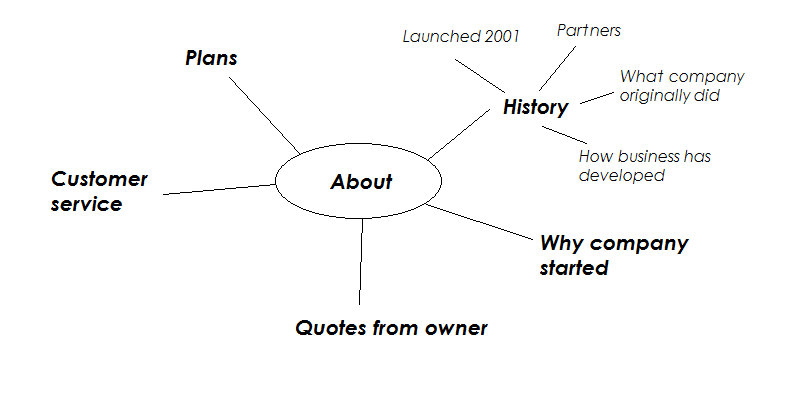People often ask me how I put together web pages, articles, blogs and emails so they don’t ramble and get the point across effectively. To be honest, after years of writing, I’ve got quite good at doing the analysis of where I’m going and what the key points are and just writing, but I learned by using a planning tool.
I was introduced to it as ‘pattern notes’, but most people call it ‘mind-mapping’ – a term invented by Tony Buzan.
I’ve written everything from an email to a book using this method and it’s a simply way to gather information together.
You start with your core subject in the middle of a page – I use scrap paper and find that it works better in landscape than portrait. You then create ‘arms’ from the main subject with your main key points (now it starts to look like a spider – and some people call them ‘spidergrams’).
From here you develop each point with more arms from each key point identifying the things you want to include around each point – so for an About page for a website it might look a bit like this:
The plus of mind-mapping as opposed to linear notes is that you can organise as you go so inserting an ‘arm’ anywhere is easy, it saves having to squeeze notes between lines!
When you’ve got all your key subheadings and information in place writing gets a lot easier as you start with an intro and then write around your ‘skeleton plan’ in order. In no time at all you’ve got an article, blog, web page or email done and dusted!
You may need to do a bit of editing and you’ll almost certainly remember bits of information that you want to add to your content, but you won’t be sitting staring at an empty screen trying to decide what to write!
Tips
If it’s a long piece (or a book) break it into main headings (or chapters) and then create a mind-map for each one.
Include case studies, anecdotes, testimonials, quotes and other evidence that validate what you’re saying.
If you’re writing for commercial purposes ensure the introduction is benefit-loaded and captures attention to encourage readers to stay engaged.
Create an attention-grabbing headline that does one of these:
- Helps people to recognise themselves and identify with what the item is about
- Intrigues people enough to want to find out more
- Offers information of value
In an email this will be the subject line that gets them to open it!
When you’re writing always keep your reader in mind and talk about them, not about yourself (or much more about them than you – count the ‘wes’ and the ‘yous’).
Finally – the more you do the easier it gets, practice often!

